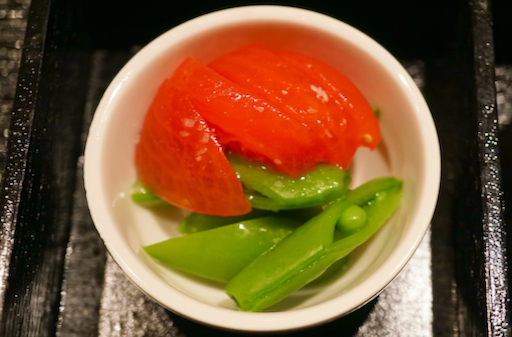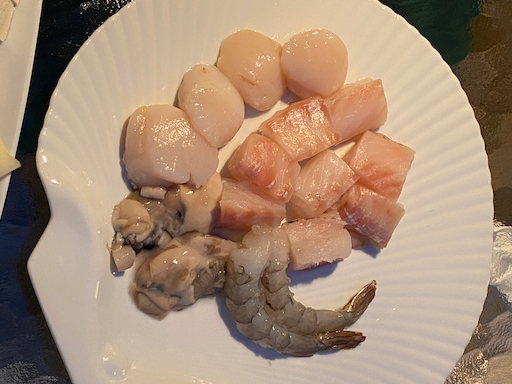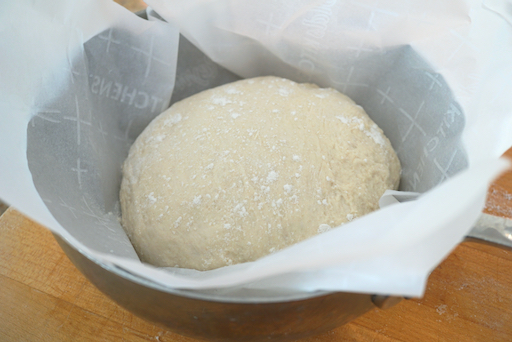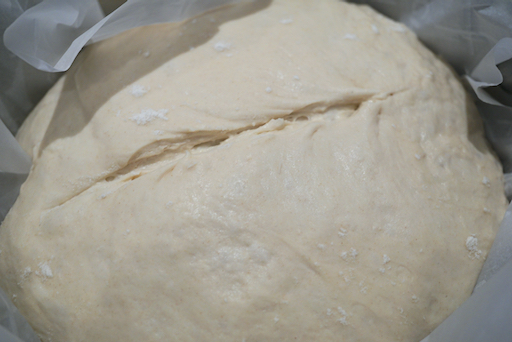When we were organizing our cookbooks and recipe print-outs, we found a small book called "Cook's Illustrated All-Time Best Bread Recipes" (published in 2018). We had completely forgotten about this book. While I was browsing through it, I came across "No-knead bread 2.0" by J. Kenji Lopez-Alt. This was based on the "no-knead bread recipe" by Jim Lahey which was popularized by Mark Bittman when his recipe was published in the New York Times. We learned about Jim Lahey's recipe through the
Washington Post and bought his book. I made a
few of the no-knead bread recipes from the book and they were great. But I have to agree with Kenji that because of the high hydration rate of 75-80% in the original recipe, the dough is very difficult to handle. In addition, placing the uncooperative dough in a hot cast iron pot runs the real risk of seriously burning yourself. As a result with some degree of struggle, it usually gets into the pot whatever way you can manage without burning yourself. Fingers may be intact but at the expense of bread somewhat irregularly shaped. Also, the shape tends to be rather flat since the dough deflates a bit when placing it in the hot cast iron pot. This v 2.0 recipe reduced the hydration to close to 70%, and has added vinegar and beer for additional flavor. Also, you knead it a little so it is "almost" no-knead bread. Instead of putting the dough on a floured dish towel for the second rise, it happens in a skillet (or bowl I suppose) lined with parchment paper. You can then transfer the dough using the parchment paper on which it is sitting to get it into the hot cast iron pot. All these changes make it much easier to handle the dough, and produces a consistent shape and really "artisanal" bread with sour dough-like great flavors.
Nice crust and good texture (multiple irregular holes).
Ingredients: (I am listing the original Kenji's recipe and metric weight in parenthesis which I converted by weighing the ingredients but not just numerical conversion of "cups" and "tsp", "tbs").
3 cup (425g) AP flour (Instead of bread flour, this recipe uses AP flour, I am not sure why but I should try it with bread flour).
3/4 cup plus 2 tbs (207g) water
6 tbs (80g) beer*
1 tbs (13g) white distilled vinegar (I used rice vinegar)
(Total liquid of 290g which makes hydration rate of 68%)
1 1/2 tsp salt
1/4 tsp instant yeast
*Kenji recommends to use light Pilsner-style lager beer such as Budweiser. I did not have Bud in our fridge so I used Sam Adams' Boston lager.<
Directions:
In a bowl, mix the ingredients using a wood spoon until no dry flour remains.
Cover the bowl with plastic wrap and let it rise for 8-12 hours in a warm place (I used
our proofing box at 85F for 8 hours).
Take the dough out and put on a floured board and knead 10-15 times. Make into a boule-shaped dough ball.
Place the dough in a parchment paper lined skillet (below picture. Kenji's recipe include spraying with vegetable spray but I do not see the need for that and skipped that process).
Place this uncovered in the proofing box (the box has a water tray providing moisture to prevent a skin from forming on the dough). Let it rise for the second time for 1-2 hours.
Meanwhile, put the cast iron pot in the oven and preheat the oven to 450F at least 30 minutes before the second rise is done.
Using a lame, slash the top of the dough (see below).
Transfer the dough to the hot cast iron pot using the parchment paper.
Bake for 30 minutes with the lid on and 5-10 minutes more minutes with lid off.
As you can see in the picture below the resulting loaf was picturesque. It actually came out exactly like the picture in the book (on the front cover of the book).
Let it cool down completely (at least several hours or more) on a cooling rack before slicing.
When I mixed the dough, I thought this is too dry and would not work. But after 8 hours of rising, the dough was quite wet but it could be handled and kneaded. Using the parchment paper made transferring the dough to the hot cast iron pan much easier and safer. It also didn’t result in somewhat deflating the dough as happened with other method. Since the dough can be formed and slashed, it came out exactly like in the picture.
We lightly toasted a slice, lavishly buttered it and tasted. The crust was crunchy and the interior moist. The flavor was wonderful. The vinegar and beer emulated the sour dough taste complex and added real depth of flavor. This is definitely the best bread of this kind I ever made.

























